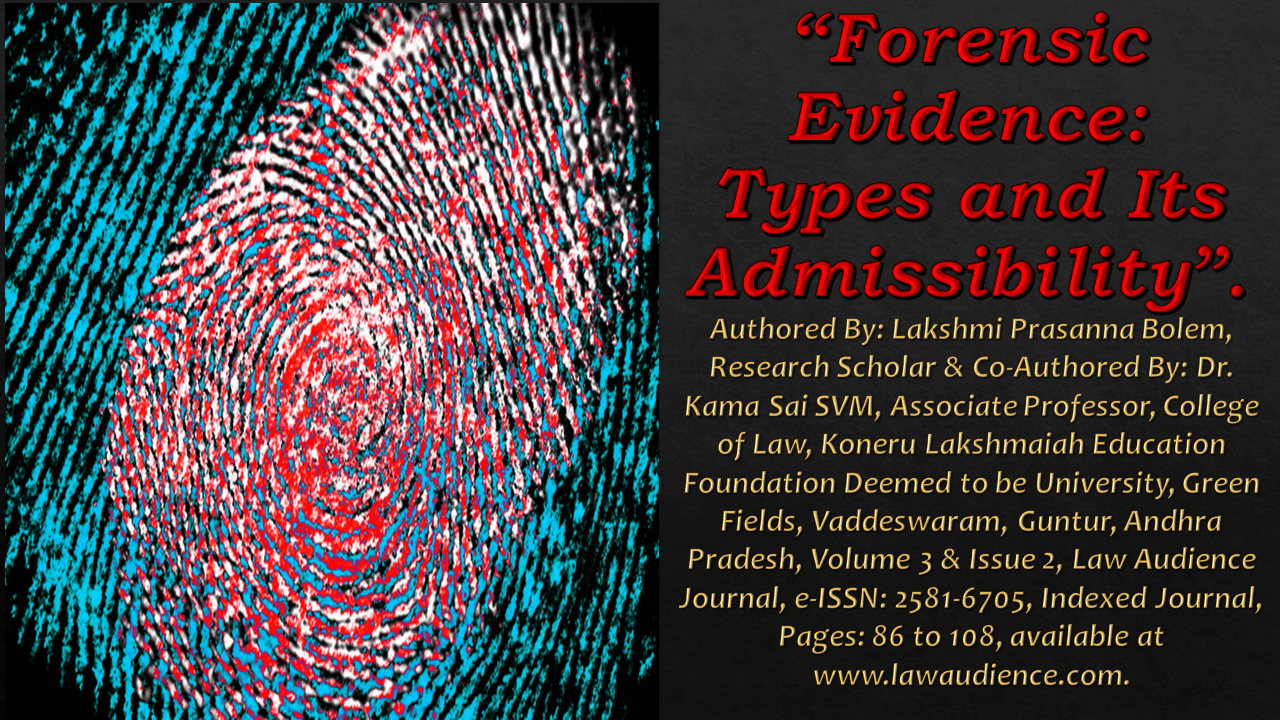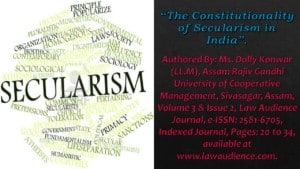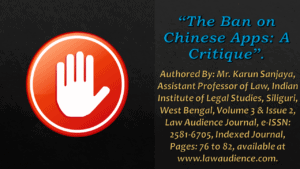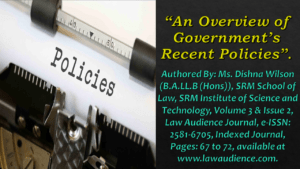Click here to download the full paper (PDF)
Authored By: Lakshmi Prasanna Bolem, Research Scholar & Co-Authored By: Dr. Kama Sai SVM, Associate Professor, College of Law, Koneru Lakshmaiah Education Foundation Deemed to be University, Green Fields, Vaddeswaram, Guntur, Andhra Pradesh,
Click here for Copyright Policy.
ABSTRACT:
“Investigation refers to the proceedings or steps taken by the police officer for the collection of evidence to determine the truth as to the occurrence of such offence. There are certain crimes like homicide, sexual offences etc., which require investigation using forensics to identify or eliminate possible suspects, as most of the time there are no eyewitnesses and the punishment for such offences is either imprisonment for life or death. Moreover, the guilt of the accused has to be proved beyond reasonable doubt. This study discusses about the types of Forensic evidence, some cases in which the forensic evidence helped in finding the culprit and admissibility of such evidence in court of law”.
I. INTRODUCTION:
The word “Forensic” is derived from the Latin word “forensic”, which means “of or before the forum”. Forensic investigation is the gathering and analysis of all crime-related physical evidence in order to come to a conclusion about a suspect. Forensic evidence is one of the most prominent aspects of today’s justice system. Forensic evidence is collected by way of Forensic investigation. Forensic investigation is often referred to as forensic science, which is the application of science to criminal/civil law. Forensic science encompasses many different fields of science including Anthropology, Biology, Chemistry, Engineering, Genetics, Medicine, Pathology, Phonetics, Psychiatry, and Toxicology. Forensic science is also known as criminalistics. Criminalistics refers more specifically to the scientific collection and analysis of physical evidence in criminal cases.
This includes the analysis of any kinds of materials, including blood, fibres, bullets, fingerprints, footprints, palm prints, lip prints. It also deals with issues such as the validity of tape-recorded messages, the identification of speakers on recorded messages and, analysis of human genetic material or DNA. There are several types of Forensic evidence which are collected and examined in the laboratory to find out the real culprit involved in the crime.
II. MOST COMMON TYPES OF FORENSIC EVIDENCE:
II.I BLOODSTAIN:
Bloodstain pattern analysis is the use of the blood stain size, shape and distribution patterns found at a crime scene in order to determine the bloodshed events. Bloodstain patterns reveal not “who” but “what and how” concerning the bloodshed event.
The bloodstain patterns at a crime scene can be used for the following purposes;
- To know about the direction of travel of the blood drops.
- To know about the distance of the blood source to the target surface.
- To know about the nature of the force and the object used to cause bloodshed, the number of blows involved, and the relative location of persons/objects near the bloodshed.
TYPES OF BLOOD STAINS:
| Passive: | Spatter: |
| Spherical / circular drops | Result of force |
| Dried and sticky drops on surfaces | Size of splatters indicate force intensity |
| Blood drops with tails | Blunt force trauma, gunshots, explosions, collisions. |
PASSIVE BLOOD STAINS:
Passive blood stains:
- Formed from the force of gravity
- Subdivided (drops, drip patterns, pools, clots)
- Oozing or gushes from the body, dripping finger or arm drops from a knife.
Transfer stains:
(1) A wet bloody surface comes in contact with a secondary surface.
(2) Wipe, smudge, swipe, or smear.
Projected blood spatter:
Blood Pools or Flows or Blood Clots.
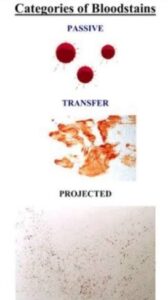
SPLATTER BLOODSTAINS:
As compared to passive bloodstain patterns, which typically falls as drops as a result of gravity, spatter bloodstain patterns often arise due to additional force or motion to the bleeding source. This indicates that a much more energetic force was used to cause the blood to break into smaller-sized blood spatters or spheres. The amount of energy involved in the force will determine the size of the blood spatters.
More specifically, smaller patterns indicate that a greater amount of force was used. Blood spatter can be classified as medium or high force impact spatters, which are often the result of blunt or sharp force trauma, will typically exhibit blood drops that are much smaller than those seen in passive bloodstain patterns.
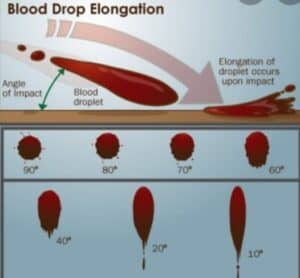
II.II DNA EVIDENCE:
One of the most reliable forms of evidence in many criminal cases is in our genes, encoded in DNA (deoxyribonucleic acid). The universally accepted theory underlying DNA analysis is that every person (except an identical twin) has certain elements of his or her DNA (deoxyribonucleic acid, which makes up chromosomes) that are unique. DNA is generally used to solve crimes in one of two ways. In cases where a suspect is identified, a sample of that person’s DNA is compared to evidence from the crime scene. The results of this comparison may help establish whether the suspect committed the crime or not. In the case where a suspect has not yet been identified, biological evidence from the crime scene is analysed and compared to offender profiles in the DNA database to help identify the perpetrator.
Although DNA evidence alone is not enough to secure a conviction today, DNA profiling has become the gold standard in forensic science. Today investigation can retrieve DNA profiles from skin cells left behind when a criminal merely touches a surface. This improved sensitivity combined with new data analysis approaches has made it possible for investigators to identify and distinguish multiple individuals from the DNA in a mixed sample.
LANDMARK CASES:
- Nitish Katara Murder Case[1]: In this case, it was very difficult to find the person guilty, because only a small portion of the palm with the finger was left unburned. But with the help of forensic science, the DNA test was conducted and it helped in identifying and recognizing the body by matching the DNA with the parents. This also helped the High Court of Delhi to identify the accused.
- Sushil Mandal vs. The State spoke to by CBI[2]: In this case, the father of a deceased boy is the petitioner, who challenged the findings of the DNA. The boy, who died, and a girl from his school had mutual infatuation. Hence, their parents were requested by the principal of the school for having a check on the children. After a few days, the boy was found missing and after a week, a body was found in a lake that was totally decomposed and hence unidentifiable. The petitioner was not able to identify the body, the clothes were also not there to identify that he is his son. He filed a habeas corpus petition in the High Court alleging the girl’s father and requesting the High Court to direct the investigation through CBI. Then the DNA test was conducted by the experts and the DNA of the deceased person matched with the petitioner and his wife also. There was also a skull superimposition test. This test also found a link between the deceased and the recovered body. But the petitioner was not able to accept the truth. The truth came only when the scientific tests were conducted. The apex court relied on the scientific tests that were conducted and hence the matter got closed.
II.III ENTOMOLOGY:
Forensic Entomology is the study of anthropoids, especially insects associated with crimes. Although it is mostly applied for the investigation of death, it is also helpful in the detection of drugs and poisons, determination of the location of an incident, and estimation of the time of infliction of wounds. An investigation based on cases of pest infestation and their associated toxicity and deaths can be encountered by forensic entomology. The pesticide toxicity can be detected in the case of the use of pesticides in the agriculture field, garden, food storage rooms, and others. This involves the searching, identification, and collection of entomological evidence from the scene of the crime like murder, rape, physical abuse, suicide, and contraband trafficking.
A forensic entomologist has to perform the following activities for the purpose of a criminal investigation;
- Required to visit the scene of the crime, where he/she has to identify the human remains and insects, collect and preserve the evidence and send the same for laboratory analysis.
- Study various aspects of the insects, observe the type of insect, growth, development, and damage caused by these insects to the dead body.
- Determine whether the insect species is native to the place where the dead human or animal remains were found.
- Require to prepare the expert testimony on the basis of the analysis of the insect evidence.
- Present the testimony in the court of law to provide the evidence for proving the commission of a crime.
II.IV DENTISTRY:
Forensic dentistry is the study and practice of aspects of dentistry that are relevant to legal problems. It is of considerable legal importance for several reasons. Teeth are very resistant to damage caused due to fire, crashes, and explosions. Forensic dentistry is very useful for the following:
- Identification of human remains from mass disasters (e.g., airplane crashes, natural disasters, wars, terrorist attacks)
- Analysis of facial injuries in cases of suspected battery.
- Analysis or identification of bite marks (i.e., sex crimes, homicides, other types of crimes).
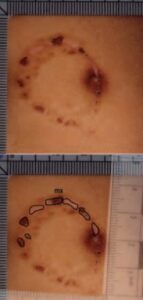
II.V LIP PRINTS (CHEILOSCOPY):
Cheiloscopy is a forensic investigation technique that deals with the identification of humans based on lip traces. Lip prints have to be obtained within 24 hours of the time of death, to prevent erroneous data that would result from post mortem alterations of the lip. The lip print pattern depends on whether the mouth is opened or closed. In closed mouth, position lip exhibits well-defined grooves, whereas in the open position the groves are relatively ill-defined and difficult to interpret. The foundations of Cheiloscopy, however, are the same as that of dactyloscopy, that is to say, lip prints are invariable, permanent, and allow establishing a classification.
CLASSIFICATION OF LIP PRINTS:
In 1967, Santos was the first person to classify lip grooves He divided them into four types namely:
- Straight line 2. Curved line 3. Angled line 4. Since-shaped line.
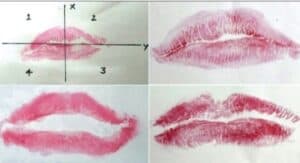
METHODS OF RECORDING LIP PRINTS:
The following are the various methods of recording the lip prints of a subject;
Method 1: A fingerprint roller is used to apply the special paper [used in finger printing] over the lips. The print is then traced onto cellophane paper and examined under a magnifying glass.
Method 2: Half-size photographs of the lips are taken with a Medical Camera and enlarged to double its size, thus obtaining life-size photographs. It should be ensured that the subjects are calm so as to get a clear photograph. The advantage of this method is that it removes the inaccuracy associated with the strength and direction of the pressure applied in taking lip prints by other methods.
Method 3: Conventional lipstick is applied with a single motion evenly on the lips. The subject is asked to rub his or her lips together to spread the lipstick more uniformly. A print is then taken on a paper with the centre portion of the lips being dabbed first and then pressed uniformly to the left and right corners of the lips.
Method 4: This is a slight modification of the previous method, where the paper used to take the impression of the lips is well supported by cardboard.
Method 5: This method also utilizes lipsticks, but the lip print is taken on a strip of cellophane tape which is glued on one side. This is then stuck on a strip of white paper which serves as a permanent record of the print.
Method 6: Dental impression materials can be used to make casts of the lips, in order to record and study the grooves on them. These materials are employed for a variety of uses such as making study models for orthodontic treatment, casts for construction of maxillofacial prosthesis and dentures, etc.
DIGITAL METHOD:
Similar to the use of scanners to record fingerprints, computers can be used to record lip prints as well. Digital images of lip prints can be stored in a computer that may be compared with prints obtained from a scene of the crime. The prints can then be analysed using software for Cheiloscopy.
Along with other traditional methods, Cheiloscopy can also serve as a very important tool in the identification of a person. Just like fingerprints and teeth, lip print can be used as a tool for identification. Lip prints are unique and do not change during the life of a person. Traces of lips should be looked for on cutlery and crockery items, on the window or door glass, photographs or letters, plastic bags, and cigarette ends. They can be most frequently seen during murders, rapes, and burglaries. Lip prints have the same value as dactyloscopic traces. In the case of traces, in the shape of strains, the identification examination terminates with group identification in their character they are similar to other chemical and biological traces.
II.VI FINGERPRINTS:
To understand why fingerprints are so crucial to forensic science, one first has to understand what a fingerprint is and how they are retrieved. A fingerprint is a unique image produced when the folds, twists, and turns of the ridges on the pads of the fingers are scanned or pressed on paper after being pressed on ink. Every person in the world has distinct variations in their ridge folds, twists, and turns. So, a fingerprint image is like a little stamp that says “I was here”. No two people have the same ridge variations. Crime scene investigators usually gather these prints by physically lifting them with fingerprint powder and sticky tape. But new technology also lets crime scene investigators take digital scans of fingerprints that are too fragile to lift.
PRINCIPLES BEHIND FINGERPRINT ANALYSIS:
The furrows and ridges present on our fingers, toes, and palms create a unique pattern. Fingerprint analysis relies on this unique pattern and forensic scientists will group patterns into the following distinct groups:
- Loops: This pattern recurves on itself and forms a loop shape. This can be further divided into a radial loop that points towards the thumb or an ulnar loop that points towards the ulna bone. These loop patterns form the majority of the fingerprint (60%).
- Whorls: These are circular patterns similar to whirlpools. They can be plain or concentric whorls, a central pocket loop that is a loop with a whorl at one end, a double loop (two loops in an S-shaped pattern), or an accidental loop that carries an irregular shape. These patterns constitute about 35% of a person’s fingerprint.
- Arches: These are wave-like and consist of plain arches and bent arches that rise to a sharper point compared to plain arches. These patterns form 5% of the fingerprint.
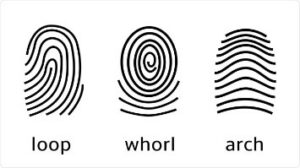
Not every crime scene has DNA evidence that is useful for prosecuting or defending a case. Evan Sycamnias of Uplink states that, in these situations, fingerprints are one of the most important factors in crime solving because they may be the only means of identifying the people who were at a crime scene or who are involved in a crime. In some instances, criminalists may use fingerprints not only to identify criminals but also to identify their victims and missing persons. Fingerprints may not prove with 100% certainty that someone committed an offence. However, fingerprints greatly reduce the number of suspects and they can establish or refuse a suspect’s alibi in order to create reasonable doubt.
II.VII AUTOPSIES:
An autopsy is a post-mortem examination of a body after death. There are generally three types of autopsies. Medico-Legal Autopsy or Forensic or Coroner’s autopsies, Clinical or Pathological autopsies, and Anatomical or academic autopsies.
MEDICO-LEGAL AUTOPSY OR FORENSIC OR CORONER’S AUTOPSIES:
Medico-legal autopsy or forensic or Coroner’s autopsies are performed to identify the cause and manner of death and to identify the deceased. They are generally executed as dictated by applicable law, in cases of violent, suspicious, or sudden deaths, deaths without medical assistance or during surgical procedures. It is performed by a Police Surgeon.
The Medico-legal expert must, without delay be informed of all relevant circumstances relating to the death, ensure that photographs of the body are taken, record the body position and its relation to the state of the clothing and to the distribution pattern or rigor mortis and hypostasis, as well as the state of post-mortem decomposition. Examine and record the distribution and pattern of any bloodstains on the body and at the scene, as well as other biological evidence proceed to the preliminary examination of the body. Record the body core temperature and the ambient temperature, the strength of the rigor mortis and the livors, as well as other appropriate findings (i.e., putrefaction). These findings are taken into account in order to estimate the time of death, or rather the time since death, ensure that the transport and storage of the corpse in the cold storage chamber is performed in a supine position, changes to this requirement must be explicitly ordered for by the medico-legal expert, possibly by personal instruction of the undertaker.
CLINICAL OR PATHOLOGICAL AUTOPSIES:
Clinical or Pathological autopsies are executed to diagnose a particular disease or for research purposes. They shed light on the pathological processes that lead to the death of the person. Clinical autopsies are sometimes performed to assess the standard of care of hospitals. It is done by a pathologist.
ANATOMICAL OR ACADEMIC AUTOPSIES:
Anatomical or academic autopsies are performed by students of anatomy for study purposes. This is usually possible when a person has given permission in advance of their death.
II.VIII SEMEN:
Sperm detection can be an important factor in confirming sexual assault in cases of rape. A large number of cases received in a forensic laboratory involve sexual offences, making it necessary to examine exhibits for the presence of seminal stains. Microscopic examination of semen is a confirmatory test in forensic serology to identify whether it is semen or not. The experiment carried out by an expert follows a protocol and according to that, the experiment takes place. The collected samples are first sealed and sent to the forensic lab. Sample slides are prepared and examined under a microscope. These prepared semen sample slides will be used as forensic evidence for future investigation. For forensic purposes, the composition of semen can be simplified into two components, seminal fluid, and spermatozoa. Microscopically identifying spermatozoa is an absolute indicator that semen is present on an item. In sexual assault cases, the detection of semen on a sample supports an allegation of sexual contact and indicates the presence of DNA from a male source. Ideally, techniques employed should demonstrate high sensitivity and specificity and should be compatible with standard DNA type procedures.
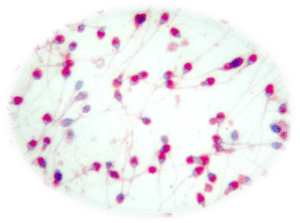
The following considerations should be taken in order to help the forensic examiner to define the best practices in each case and to interpret the findings;
- Semen (spermatozoa suspension in the seminal fluid) is rarely present in oral, anorectal, and vaginal cavities for 6, 24, and 72 hours after sexual contact. In the vaginal cavity, the half-life time depends on the age of the victim (pre- or post-pubertal) and if the semen is localized in the cervix, the half-time may be much higher than 72 hours. In post-pubertal girls, spermatozoa may remain motile in the vaginal secretions for 6 to 12 hours and in the cervix for as long as 5 days. Non-motile spermatozoa may be found in stains of vaginal secretions from 12 to 48 hours after ejaculation. The half-life of semen in the pre-pubertal girl is comparatively shorter due to the absence of cervical mucus. Dried discretions on clothing remain quite stable, so that semen may be detected for longer than 1 year. These half-lives represent mere estimations since several variables (that should be described in the forensic medical report) must be considered when documenting the presence or not of semen in sexual assault cases.
- The type of practice and circumstances (e.g., where evidence is deposited, ejaculation occurred in the skin, oral, anal, or vaginal mucosa or in the cervix; condom use; the perpetrator is azoospermia or vasectomized.
- The time between sexual contact and evidence collection.
- Victim’s gender, age, and activities (ex. urinating, defecating, vomiting, brushing teeth, bathing, eating, drinking, smoking, spitting, running, and walking) after sexual contact.
- Observations of spermatozoa under an optical microscope (e.g., using stains such as the kernechtrot (KPIC or Christmas Tree stain), Giemsa, haematoxylin/blue/eosin or by phase-contrast microscopy (no stains). These are considered for the diagnosis of sexual contact and the concomitant observations of motile spermatozoa allow estimating the time of the assault.
FORENSIC SIGNIFICANCE:
It is useful because the relative quality of spermatozoa and epithelial cells can be assessed. This determination becomes important during subsequent DNA analysis because spermatozoa contain male DNA, while most epithelial cells in the male-female sexual assault will contain female DNA from the complainant. It is also useful because the relative quantity of spermatozoa and epithelial cells can be assessed.
Many times, in sexual assault cases semen samples contain contamination like epithelial cells and dust. This can be solved by microscopic examination of samples and also gives information on semen maturity.
II.IX DRUG EVIDENCE:
Drug analysis is as multifaceted as the range of illegal drugs that flood the market each year. The goal is to provide a reliable and a fast method for the unambiguous determination of illegal substances inside and outside the body. The ultimate purpose of forensic drug collection, preservation and analysis is to ensure such evidence is legally admissible as evidence in a court of law. That’s why it’s an investigator’s job to ensure the integrity of the drug evidence, they have collected from the time they laid their hands on it until the time it is presented as evidence in court.
DETECTION OF INTOXICATION THROUGH BREATH/BLOOD TEST:
The legal system has several different reasons for drug testing. One is to determine whether a criminal offender used drugs because intoxication is a circumstance that can affect what crime a person is charged with and the punishment that may be given. For example, a widely used technology of breath analysis is to determine the blood alcohol concentration (BAC) of people operating a motor vehicle.
It is not only a crime to operate a motor vehicle while intoxicated, but it may be a criminal aggravation of another offence, such as an injury occurring during the course of an accident.
TYPES OF TESTING:
The term “drug testing” means the use of chemical technology to analyse a biological sample in order to detect the presence of a drug or drug by-product. The most common samples currently used are urine and blood, but hair, sweat, and saliva samples are becoming more popular. The single most frequently used technique for alcohol is breath analysis.
Blood: Drugs can be identified in the blood. Using blood as a sample can create problems. For example, collecting blood specimens, or samples, with hypodermic needles is invasive and painful. There is the possibility of infection from the necessary puncture wound. In addition, blood can be the source of a disease such as AIDS or hepatitis. Blood samples can also be difficult to transport and store (for example, they require refrigeration and the use of special additives or preservatives). Moreover, blood specimens are not very stable and any break down over time and become unusable unless special precautions are taken. Finally, when testing blood, the retrospective period or the period of time between drug use and the collection of a sample during which a drug can be identified is quite short for most drugs.
Urine: Urine is the single most frequently used specimen for detecting commonly used illicit drugs. The use of urine samples has many benefits. First, the collection is non-invasive, since urine is collected without any use of needles. Second, urine, unlike blood, is a concentrated fluid, so the amounts are high compared to the levels found in the blood. Third, the urine will contain high concentrations of both the drug of interest (often called the parent drug) and drug by-products or metabolites.
Hair: The drugs, a person consumes become trapped in the user’s hair. Laboratory analysis of hair can reveal the presence of a variety of drugs, including heroin, cocaine, amphetamines, phencyclidine, marijuana, nicotine, and barbiturates.
Sweat and Saliva: In recent years, both sweat and saliva have been considered potential samples for drug testing. These materials generally have the same limitations that urine does – a short time frame during which drug presence can be identified. Additionally, saliva, if collected right after drug use, will also be influenced by the amount of possible residual drug in the mouth, so it may not work well as an estimator of blood concentration. Sweat testing has been incorporated into a “sweat patch” that is currently on the market and used as a long-term monitoring device. An absorbent pad with a tamper-proof adhesive is affixed to a person’s body (typically the upper arm or upper back). This pad absorbs sweat over a relatively long period of time. If the person has used drugs, the sweat will contain both drugs and drug metabolites, which can be extracted and identified. Both of these techniques are relatively new and have not yet been widely used, but they may become more prominent in the future.
Breath: Breath testing is a technique commonly used by law-enforcement authorities to test for alcohol. Testing can be done with a Breath analyser or other breath analysis machines. Breath tests actually rely on detecting alcohol in the water vapour that is a component of breath. To determine blood alcohol concentration, the Breath analyser tests the exhaled breath and the water vapour in it to estimate the blood plasma alcohol concentration. This test is popular because exhaled breath is convenient to collect and is non-invasive, meaning that the skin is not pierced to collect blood or body fluids.
III. EVIDENTIARY VALUE OF FORENSICS AND CONCERNED SECTIONS IN LAW:
The relevancy theory governs proof of admissibility. In our country, the rules of admissibility state that proof can only be submitted of specific facts and facts in question. A fact can be true but not admissible, as in the case of historical testimony, where secondary evidence of a record may be provided only under such conditions. If it does not accommodate the legislative provision, a document may be relevant but not admissible. It is also possible if a text or an expert opinion is admissible whether it is original or otherwise, but because it is irrelevant, such documentation is not recognized by courts. As a result, the criteria for recognizing forensic evidence in our country are relevancy and admissibility.
In the Indian law context, laws related to Forensic Science are more numbered in the Indian Evidence Act (IEA), compared to Code of Criminal Procedure (Cr.P.C) and Indian Penal Code (I.P.C). Forensic Science is admissible in Indian law considering the IEA, within 4 aspects: Witness, Admission, Facts and Circumstantial evidence. Here are superficial details of some widely known laws that make forensic evidence admissible in the court of law:
Most important and widely known aspect of Forensic Science is DNA and it’s testing. There is no official legislation passed w.r.t. to DNA testing in the Indian constitution, but Sec 53 and 54 of CrPC deals with examination of alleged person by a certified medical practitioner on reasonable grounds of inquest.
Sec 293 of CrPC. lists some Government Scientific Experts for the admissibility of expert opinion in the court of law. The expert is examined as a witness for his/her opinion to be valid after cross examination. Also, Sec 45 of Indian Evidence Act provides relevancy to expert opinion in any field of expertise in forensic science, to help the court in framing judgements considering technically complicated and sophisticated matters.
Forensic Toxicology has been the most active branch of Forensic Science where separate acts were introduced amending the existing laws and legislations. Sec 272 to 278, Sec 284, Sec 328 of I.P.C deals with poisoning. Along with general description of poisons, corrosive substances, adulterants, chemicals and medico-legal aspects, there are Acts like:
- The Poison Act (1990);
- Drugs and Cosmetics Act (1940);
- Narcotic Drugs and Psychotropic substance (NDPS) Act (1985);
- The Pharmacy Act (1948);
- The Drug Control Act (1950);
Another commonly heard term w.r.t. Forensic Science is fingerprints. According to Sec 73 of IEA any person is compelled to give his/her fingerprints on orders from the court. The Supreme Court has given special mention that this section isn’t a violation of their fundamental rights. Sec 5 and 6 of Identification of Prisoners Act has the same context and allows acquiring thumb impressions and handwriting samples. It also declares that these shall not be used against the person as personal testimony. Forgery, fraud and cheating are quite common in current scenario and are gaining momentum to be the commonly occurring white-collar crimes. Indian laws have defined every term related to crimes related to documents;
- Sec 29 of I.P.C. defines document.
- Sec 29A of I.P.C. defines electronic records.
- Sec 463 of I.P.C. and Sec 44 of IEA defines forgery.
- Sec 420 of I.P.C. defines cheating and Sec 417 defines punishment for the same.
Sec 47 of IEA is for handwriting opinion and elaborates the circumstances under which the handwriting expert shall consider it to be a disputed handwriting. - Sec 67 of IEA gives details of methods of how a signature in a document should be proved.
NARCO-ANALYSIS TEST – POLYGRAPH TEST:
In case of offences like Terrorist attacks or Scams effecting the economy of our country, in order to know the truth where accused alone can give the information as to conspiracy and involvement of other persons then the Narco-analysis test and Polygraph test are done. Narco-analysis test is a restoration of memory which the suspect had forgotten.
The test is done by a team comprising of an anaesthesiologist, a psychiatrist, a clinical/forensic psychologist, an audio-videographer, and supporting nursing staff. The forensic psychologist will prepare the report about the revelations, which will be accompanied by a compact disc of audio-video recordings. The strength of the revelations, if necessary, is further verified by subjecting the person to polygraph and brain mapping tests. Narco-analysis is steadily being mainstreamed into investigations, court hearings, and laboratories. Narco-analysis came in the limelight in the context of infamous Nithari village (Noida) serial killings. The two main accused in the Nithari serial killings Mohinder Singh Pandher and Surendra Kohli had undergone Narco-analysis tests in Gandhinagar in Gujarat. Narco-analysis was also used in the interrogation of Ajmal Kasab, the main accused in the 26/11 attacks in Mumbai.
POLYGRAPH OR LIE DETECTION TEST:
It is an examination, which is based on an assumption that there is an interaction between the mind and body and is conducted by various components or the sensors of a polygraph machine, which are attached to the body of the person who is interrogated by the expert. The machine records the blood pressure, pulse rate and respiration and muscle movements. Polygraph test is conducted in three phases- a pre-test interview, chart recording and diagnosis. The examiner (a clinical or criminal psychologist) prepares a set of test questions depending upon the relevant information about the case provided by the investigating officer, such as the criminal charges against the person and statements made by the suspect.
In KM. Seema Azad vs. State of U.P. on 22nd April, 2013[3]:
Facts: Also called Shashi (law student of Faizabad) murder case. In this case, when Vijaysen Yadav (co-accused) underwent Narco-analysis test, said that the then incumbent BSP MLA, Anand Sen had illicit relations with Shashi who eventually got pregnant, he asked Vijay Sen to murder her. Vijay Sen in his trance like stage even revealed that after the said incident, Anand called him and told him that he had pushed her into a canal and strangulated her with his own hands and then disposed her body in the canal only. This was further corroborated with the help of phone calls between Anand and Vijay Sen from the site where Shashi was murdered. On the basis of Vijaysen’s statements recorded in the Narco-analysis and polygraph test, police arrested Anand Sen who was at the moment, minister in Mayawati cabinet.
In the case of Selvi vs. The State of Karnataka, Anr[4], the Supreme Court ruled that compulsory administration of forensic techniques such as polygraph, was unconstitutional if conducted without the permission of the accused as it violates Articles 20(3) and 21 of the Indian Constitution.
In the case of Mahmood vs. State of U.P[5], the Supreme Court described the term expert and stated that convicting anyone solely on the testimony of an expert would be extremely dangerous. While prosecution based on expert testimony is risky, Sections 53 and 53A of the Code of Criminal Procedure, 1973, requires that expert evidence be used in such cases.
In the case of Magan Bihari Lal v. the State of Punjab[6], the Supreme Court struck down and set aside the conviction on the basis of the experts identifying the handwriting. The Supreme Court said that the opinion of an expert must be received with caution.
IV. CONCLUSION:
As per the Supreme Court, the data given by the expert are relevant and admissible. If any oral evidence contradicts the data/ report, it will not make the data evidence absolute. But, as per section 46, in case any fact is in contradiction to the opinion of the expert, that fact becomes relevant. If the opinion of the expert is relevant, the contradictory fact becomes relevant even though it was not relevant as such. The value of expert opinion depends upon the facts on which it is based and the competency of such expert in forming a reliable opinion. The evidence given by the expert is just an opinion and is not a fact-based testimony and thus is given slight value. This is the reason that eye-witnesses or other factual witnesses are given priority over the expert’s opinion. This is because opinion evidence cannot supersede substantive evidence.
However, the evidentiary value of an expert’s opinion depends upon the facts and circumstances. For example, if there is a dispute as to who is the biological parent of a child, the DNA report of the medical expert is of great importance. If the expert says that the DNA of the child or parents matches then it is a relevant fact in deciding the case. But in case if a handwriting expert says that the signatures match or not match with the person, this fact does not hold much value because there can be a possibility that the person has practiced a lot to copy the signature.
But on the other hand, DNA cannot be copied or changed. The court must be satisfied that the accused is guilty. The court cannot hold him guilty merely because an expert has said that in his opinion, the person is guilty. The court needs to look into the evidence along with the opinion of the expert before giving any judgement or order.
A critical analysis of the various forensic evidences reveals that it is an indispensable tool in the hands of the decision-making process of criminal cases which has to be properly used. Still some efforts and improvements are required in this field to make it much more trustworthy and dependable.
Cite this article as:
Lakshmi Prasanna Bolem & Dr. Kama Sai SVM, Forensic Evidence: Types and Its Admissibility, Vol.3 & Issue 2, Law Audience Journal (e-ISSN: 2581-6705), Pages 86 to 108 (10th November, 2021), available at https://www.lawaudience.com/forensic-evidence-types-and-its-admissibility/.
Footnotes & References:
- Benedette Cuffari, 2020. What is Bloodstain Pattern Forensic Analysis, Available at https://www.news-medical.net/amp.
- Teresa Magalhaes, Ricardo Dinis-Oliveria, Benedita Silva, Francisco Corte Real.,2015.Biological Evidence Management for DNA Analysis in Cases of Sexual Assault, Available at https://www.researchgate.net/doi/10.1155/2015/365674.
- Diva Rai, 2021. Laws relating to Forensic Science Admissibility in Indian Laws. Available at https://blog.ipleaders.in.
- William L. Krinsky, 2019.Forensic Entomology, Available at https://www.sciencedirect.com.
- Forensic Dentistry, Available at Https://www.britannica.com.
- Ranjan,V.,Sunil,MK.,Kumar,R.,2014.Study of lip prints: A forensic study, Available at https://www.jiamr.in/doi/10.4103/0972-1363.141856.
- Surat,P., Fingerprint Analysis in Forensic Science, Available at https://www.azolifesciences.com.
- Nithin Jayan,2016.Post-mortem examination or Autopsy Report, Available at https://www.medindia.net.
- Semen Analysis-Crime Museum, Available at https://www.crimemuseum.org/crime.
- Drug Testing Methods and Analysis, Available at https://www.encyclopedia.com.
- Vaishnavi Narreddy,2020.Laws relating to Forensic Science Admissibility in Indian Laws, Available at https://legaldesire.com
- Pragya Sharma, Legal Admissibility of Narco Analysis and Polygraph Test in India, Available at https://www.legalserviceindia.com.
[1] Vishal Yadav v. State of Uttar Pradesh (2014) SCC Online Del. 1373.
[2] 2014 SCC Online Mad 7362 : (2014) 2 MWN (Cri) : 580 (Mad) (1B).
[3] Criminal Appeal No.1055 of 2011, Alternate Citation: 115crilj 22 (2009).
[4] AIR 2010 SC 1974, (2010) 7 SCC 263.
[5] AIR 1976 SC 69.
[6] 1977 AIR 1091, 1977 SCR (2)1007.
